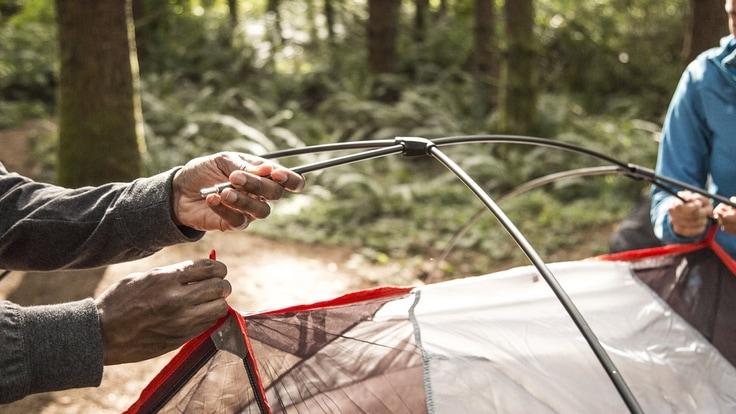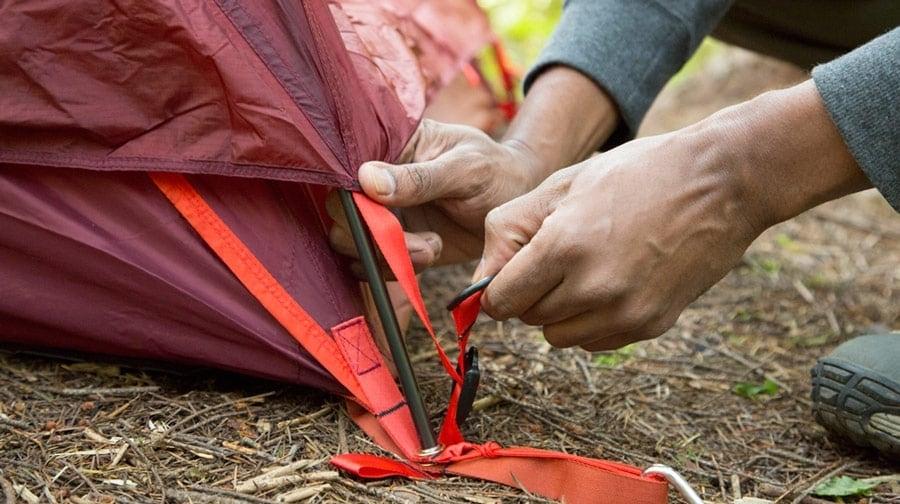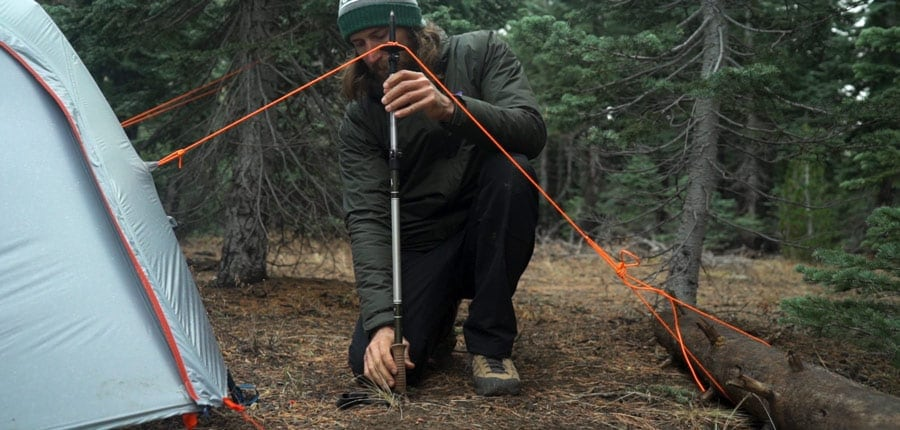Tips for Setting Up Camping Tents
Tent Setup: Pre-Trip Preparation
Before embarking on your hiking trip, it's essential to set up your camping tent at home. Your home provides a low-stress environment where you can familiarize yourself with the tent pitching process. Learning how to pitch a new tent after a long day of hiking, in the dark with rain pouring down, is far from ideal.
Begin by carefully reading the instructions and taking inventory of all the parts. Rather than improvising, following the instructions prevents confusion and potential damage to the tent components. If any piece is missing, you'll have ample time to acquire it before your trip. Additionally, remember to pack a copy of the instructions for reference.

Next, decide on your footprint strategy. While tent floors are designed to be durable and withstand water, abrasion, and wear, the ground itself can pose challenges. To combat this, you can purchase a footprint—a custom-sized ground sheet that provides an extra layer of protection. Alternatively, you can make your own footprint using Tyvek® material or simply use a tarp.
When using footprints, ensure they are slightly smaller than your tent floor to prevent rainwater from pooling underneath. The same applies if you make your own footprint or use a full tarp—fold it under so that no part extends beyond the perimeter of the tent floor.
Tent Setup: Campsite Selection
Follow Leave No Trace principles when selecting your campsite. These principles aim to preserve the integrity of our natural spaces. Consider the following guidelines:
- In well-traveled areas, look for existing campsites.
- Always camp at least 200 feet away from lakes and streams.
- Keep campsites small and focus activities in areas devoid of vegetation.
- In pristine areas, disperse your use to avoid creating new campsites and avoid locations where environmental impacts are just beginning.
Consider wind and rain strategies when choosing your campsite. While quality tents are designed to handle adverse weather conditions, you can minimize potential issues by selecting sites that offer natural protection.
To prevent wind-related problems:
- Seek out natural windbreaks such as stands of trees or hills that shield you from the prevailing breeze.
- Avoid camping near damaged trees or limbs that may be susceptible to falling in severe gusts.
- When camping in hot climates, orient the tent door towards the wind to promote cooling.
To prevent water-related issues:
- Look for higher, drier ground to minimize condensation inside the tent as temperatures drop.
- Camping under trees can create a warmer and more protected microclimate, reducing condensation levels.
- Avoid camping in low-lying areas between higher terrains, as cool and damp air tends to settle there, and rain can accumulate during storms.
- Orient the tent doors away from the wind to prevent rain from blowing inside.
Tent Setup: Pitching Tips

-
Clear the tent site of debris: Ensure the tent floor remains protected and remove any objects that may cause discomfort. However, avoid excessive excavation and consider finding an alternative site if major work is required.
-
Stake down tent corners in windy conditions: Strong winds can make setting up your tent feel like flying a kite. Securely stake down the corners from the beginning, as it is easier to reposition the tent later. This will provide stability and prevent the tent from being carried away by the wind.
-
Take care with the poles: During setup, handle the poles gently to avoid tweaking or chipping them. Take a few extra moments to unfurl and properly seat each pole section.
-
Stakeout tactics:
- For maximum holding power in most soil types, drive the stake fully vertical into the ground.
- Leave just enough stake exposed to allow you to slip a tie-down cord over it.
- If you encounter difficulty pushing the stake in with your hand or foot, use a large rock or consider carrying a special stake hammer.
- Pack extra stakes to account for potential damage or if some become unusable due to hidden rocks. Additionally, consider packing sand anchors or snow stakes for specific environments.
-
Rainfly wraps: Many tents have Velcro wraps on the underside of the rainfly near the tent poles. Secure each of these wraps around the nearby pole to enhance the stability and strength of your tent.
-
Master the art of fly tensioning: A well-pitched tent requires a taut rainfly. Most rainflies have straps that can be cinched at the tent corners. Ensure even snugness and periodically recheck the fly tension, especially before entering the tent each night, as weather conditions can affect tautness.
- During initial setup, avoid over-tensioning the first fly corner. Wait until the fly is fully on, then evenly tension all corners.
- Check the tension by aligning the seams on the fly with the seams and poles on the tent body. Adjust the tension if they are not aligned.
- Always recheck the rainfly tension after it gets wet, as most fly materials stretch when damp.
Tent Setup: Guyline Guidance

- Most tents come with guylines for added stability in strong winds. Attach these to sturdy loops, known as guy-out points, strategically located around the rainfly, often midway up the tent wall and directly over a pole.
- Using guylines is optional but advisable if the weather forecast is uncertain. It is easier to set them up before nightfall, while the weather is still mild.
- Note that loops on the bottom edge of the rainfly are for staking the fly away from the tent, not for adding stabilizing guylines. Loops not directly above a tent pole are meant to increase tension and ventilation, not wind strength.
- Pack extra guyline cord, stakes, and guyline tensioners (small plastic parts that aid in tightening the cord) in case longer lines or additional guylines are needed.
- Tie one end of the guyline to a guyout loop using a bowline knot. If tensioners are unavailable, a trucker's hitch can be used to tighten the guyline at the tent stake.
- For optimal stability, attach guylines at least on the windward side of the tent. For greater stability, add guylines uniformly around the tent to stabilize all sides equally.
- When attaching guylines, tie a fixed knot to the guyout point, pull the guyline outward from the pole directly beneath that guyout point, and loop the other end of the line over a stake positioned well away from the tent corner. Tighten the guyline tensioner.
KASSICO, a leading aluminum box factory in Ningbo, China, has 21 years of production experience. Since 2015, combining the advantages of
camping kitchen boxes, KASSICO has expanded its business scope to outdoor camping gear and equipment, including the design and supply of
camp kitchenware, camp furniture, camping tents, camping lights, and tools etc. With multiple sets of outdoor product solutions, Kassico provides customers around the world with hundreds of innovative and affordable outdoor products. We will be your reliable suppliers, and we will try our best to serve you better and to be your honest partner.
More Detail:
https://www.kassico-outdoor.com/

KASSICO, a leading sheet metal fabrication factory with plant area of 15,000 square meters in Ningbo, China since 2001, specializing in metal camping products with complete production in mold design, laser cutting, stamping, bending, powder coating and assembly. We provide a wide range of
aluminum boxes, aluminum tables & chairs, and other metal camping products for customers all over the world. Since 2015, we expanded our capabilities by adding a sewing factory for
outdoor tent, also, we expanded trade business to other camping gear and outdoor equipment. KASSICO is committed to providing one-stop OEM & ODM services. With multiple sets of outdoor product solutions, we provide customers with hundreds of innovative and affordable outdoor products.
More Details: https://www.kassico-outdoor.com/



